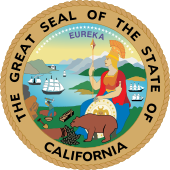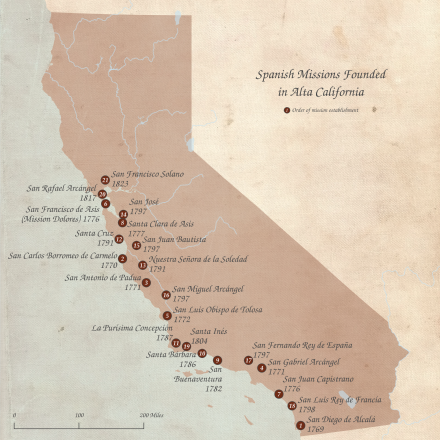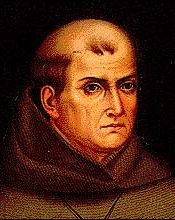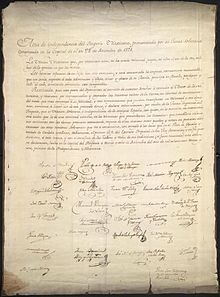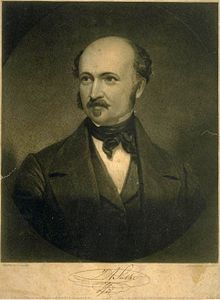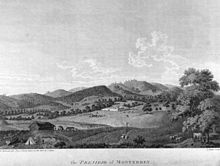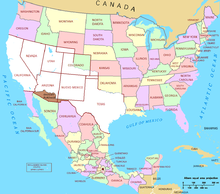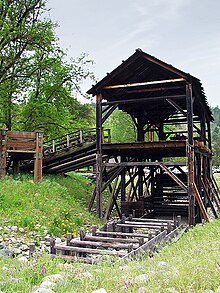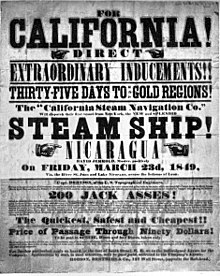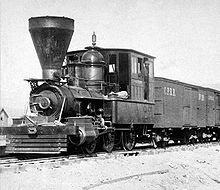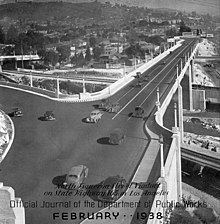History of California
The history of California began with the immigration of the first Indians 13,000-15,000 years ago. The colonization of America by the Europeans began in the 16th century. After California was admitted to the United States of America in 1848 by the Treaty of Guadalupe Hidalgo and the gold rush that broke out almost at the same time , the Europeans took control of the still young state within a few years. The Indian population was almost completely destroyed or forced to assimilate.
In the wake of the California gold rush , many people moved to the American west coast and the population grew rapidly. After the American Civil War, many Chinese, who had previously worked on the construction of the first transcontinental railroad , also moved to California , which caused various race riots.
Oil was first found in the 20th century, which gave the economy a boost. This was followed by the success of the cinema, the main center of which is still in Hollywood today . During World War II, the ports of California served as the starting point for the Pacific War ; California became a hub for the aerospace and defense industries.
After the end of the war, California saw the rise of new youth and protest cultures such as B. the hippie culture. On the economic side, the triumphant advance of the high-tech industry began, which made Silicon Valley the center of the information age .
Historical immigration movements
How the colonization of America came about is part of intense archaeological debates. A widely accepted thesis is that the first inhabitants of North America reached the New World about 16,500 years ago via the Bering Strait . They probably moved south along the Pacific coast, as is suggested by finds in British Columbia ( Far West Point ), Washington, and the Channel Islands , which were dated to an age of 9700, 12,100 and 13,000 to 11,300 Before Present .
The approximately 30 tribes in California are divided into six language groups, which means a high level of cultural diversity. This was probably the result of various migration trains. When Europeans first arrived in California, they met Indian tribes of the Chumash , Maidu , Miwok , Modoc , Mohave , Ohlone , Pomo , Shasta , Tongva and Wintu .
The different tribes adapted to the prevailing climate in their area, which led to brisk trade and cultural diversification, because the environmental conditions in the various settlement areas of California differ considerably.
Tribes that had settled on the coast specialized in the trade in mussels and pearls. Early forms of agriculture were developed in the broad Central Valley . The grass was burned to keep the soil fertile and to encourage the growth of certain wild plants, mostly oaks . The acorns were made into a powder to wash out the tart tannins and make flour from it. The tribes in the north and east of the mountains lived mainly from catching salmon and hunting. Obsidian was extracted from the volcanoes . In the deserts in the south-east lived tribes who had specialized in the careful handling of the few plants and who settled on the waterways.
Despite these adjustments, the settlement areas remained changeable. Successful tribes increased their settlement area at the expense of other tribes. Slave trade and inter-tribal wars alternated with periods of relative peace. At the time of contact with Europeans in the 17th century, there were probably around 300,000 people living in California.
Early European voyages of discovery (1530–1765)
The first European explorers sailed off the coast of California from the early 16th century to the middle of the 18th century. Their ships sailed under the flags of Spain and England . The most important colonial power, Spain, focused on its territories in Mexico , Peru and the Philippines . The Spaniards sought to extend their power to the coastlines of the whole Pacific, including California. At that time, however, the area appeared to the explorers to be hilly grassland, which was unattractive for colonization. Little did they know that California's gold deposits would have surpassed their imagination of an Eldorado .
Two names in particular should be mentioned as important discoverers of California: Hernán Cortés and Juan Rodríguez Cabrillo . Cortés made his first trip around 1533, on behalf of the then President of New Spain , Nuño Beltrán de Guzmán , who had been told by a slave of the Seven Cities of Cibola , whose streets were paved with gold and silver. Around the same time, Hernán Cortéz heard reports of a wonderful country in the northwest, populated by Amazons (female warriors), and where gold, pearls and precious stones were in abundance.
The first European to tour the coast of what is now California was Juan Rodríguez Cabrillo, a captain who set sail for the Spanish Crown. He set out from the west coast of Mexico and went ashore in the Bay of San Diego on September 28, 1542 , and then took possession of the "island" of California for Spain.
Other colonial powers weren't interested in California either; it was too sparsely populated and too far away. It was not until the 18th century that some Russian and British explorers and fur traders settled the area.
Spanish colonization and Spanish government (1697-1821)
The colonization of California was finally decided by the Spanish king at the end of the 17th century and entrusted to the Jesuits , who also held all secular authority on the condition of recognizing royal sovereignty in the California territories. In particular, the command over the accompanying Spanish troops was important.
In 1697 the missionary Juan María de Salvatierra established the Misión de Nuestra Señora de Loreto Conchó , the first permanent mission station in Baja California Sur . California was then part of New Spain . The influence and spread of the Jesuit missionaries initially increased steadily, so that by 1767 15 Jesuit mission stations were mainly distributed over historic California . One of the goals that the Spanish Crown wanted to achieve with the colonizations was the spread of the Catholic faith.
In 1767 the Spanish King Charles III. a decree following the Jesuit ban that expelled the Jesuits from New Spain or ordered them to their home countries. The Franciscans jumped into the gap that was created and pushed ahead with the construction and management of the stations.
The first permanent Spanish settlements emerged in Alta California towards the end of the 18th century . Under pressure from English and Russian trappers, the number of mission stations was increased and these are now protected by troops. This was intended to underpin Spain's claim to territory. The chain of Spanish-Franciscan mission stations reached from Loreto via San Diego to just north of today's San Francisco . The missionaries not only preached the Catholic faith, but also brought European science with them, particularly in the fields of agriculture and livestock. So cattle, fruits and vegetables were brought from Europe, which were grown in the large ranchos belonging to the missions. The locals were entrusted with many tasks on these farms.
These 21 stations, founded between 1769 and 1823, are among the oldest monuments in California and are important tourist centers in the cities that have developed around them. Therefore, many cities bear the names of Catholic saints ( San means saint in Spanish) and not, as is otherwise common in America, names of geographical features or places in Europe. The naming went so far that places were prefixed with the suffix "San", although the name was not derived from a saint at all, for example in San Ramon . This type of land grabbing by missionaries came to the Spanish King Charles III. very convenient, as money was scarce in the aftermath of the Seven Years' War .
During his third and final voyage in 1778, the British navigator James Cook mapped the North American Pacific coast up to the Bering Strait . In 1786 Jean-François de Galaup led a group of scientists on behalf of the French King Louis XVI. to California. They wrote a report on the Spanish missions, the country and the people. In the decades that followed, various traders, whalers and other scientists toured the area.
In 1819, with the Adams-Onís Treaty, the northern border of California was set at the 42nd parallel. That’s the Oregon border today .
Gaspar de Portolà
In 1768 Gaspar de Portolà undertook an expedition to colonize Alta California . They reached what is now San Diego , built the Presidio there and then moved via Santa Monica , Santa Barbara and San Simeon to San Francisco Bay . Although they had actually looked for and found Monterey Bay, they did not recognize it and passed it. Portolà's group was the first European explorer to discover the Bay of San Francisco, even though Spanish ships had been sailing past it for more than 200 years.
Portolà's group returned to San Diego in 1770.
Junípero Serra
Junípero Serra was a Franciscan from Mallorca who was instrumental in founding the Spanish mission stations in Alta California. He made his first trips to Alta California as a companion on Gaspar de Portolà's voyages of discovery. Serra was called "padre presidente" after the Jesuits were expelled from New Spain.
Russian attempts at colonization
Russian seal hunters and fur hunters had also reached California from their colony in Alaska since around 1800 and came as far as San Diego. They mainly hunted sea otters and fur seals for the fur markets in China . A Russian trading post was established in 1812 at Fort Ross , at what is now Bodega Bay , 145 kilometers northwest of San Francisco. This region was formally claimed by both Mexico and Great Britain, but was far beyond the practical sphere of influence of either state. Mariano Guadalupe Vallejo , the Commandante-General of Alta California, had the Presidio in Sonoma built in 1836 to stop the Russian advance in the region. The Russian colony in California remained active until 1841, when Fort Ross was sold to the Swiss private colonist Johann August Sutter , who expanded his territory of New Helvetia to the Pacific coast. From then on Russian America was limited to Alaska, which was finally sold to the USA in 1867.
California as part of Mexico (1821–1846)
With Mexico's independence from Spain , European rule over California also ended. The mission stations lost their importance while the ranchos and pueblos became more important. In the mid-1840s, the immigration of mainly English-speaking Americans created a new “linguistic” border through California. By 1846, Alta California's Spanish-speaking population had fallen to less than 10,000. These Californios still worked mainly on the ranchos, while the Americans and the immigrant Europeans dominated the trade. Although they were still clearly outnumbered, they quickly took on important positions. In contrast to the Californios, the immigrants were almost exclusively men.
Most of the missions themselves were small and only occupied by two Franciscans and six to eight soldiers. They were built by the locals under the supervision of the monks. In addition to the misiones , there were a few settlements ( pueblo ) and four presidios (fortresses) along the Camino Real. The stations along the 600 miles (966 kilometers) between San Diego and Sonora were each about 60 kilometers, which corresponded to a day's ride, apart. After the Mexican War of Independence broke out, the missions were not supported by the Spanish crown and later by the Mexican government, and the monks and baptized Christians in and around the station were on their own. In 1827 the now Mexican government passed a law that expelled all Spaniards from the country, with which the number of clerics rapidly declined. The government secularized several of the stations and then sold them. These ranchos , as the stations with their homesteads were called, often became the property of new settlers, who continued to operate them with the support of the converted Indians and thus quickly experienced social and economic advancement.
The Californios were not satisfied with this location. The conflict culminated in the uprising of the Monterey garrison in 1828 against the governor José Maria Echeandía . The new Mexican governor Manuel Victoria was also rejected by everyone, including the extended families who had previously resigned themselves to the system. In November 1831 there was an uprising in the course of which Los Angeles and San Diego were temporarily captured by the Californios. A similar thing happened with the "Revolution" by Juan Bautista Alvarado in 1836. He took control of the capital Monterey and deported most of the officials while he proclaimed the independence and sovereignty of California. However, he did not refuse to accept the post of governor that Mexico offered him in 1837, which meant that this "autonomy" did not come into effect.
Only after California became an American state, the Supreme Court decided that the ranchos should be returned to the appropriate medals.
The already mentioned Mexican laws declared all Spaniards to be “illegal immigrants”, which meant that most of the Franciscans had to leave. They took everything that was of any value with them, and the stations were then looted by the Mexicans or used as quarries.
Simultaneously with the increased immigration of Americans, compatriots from several other states also invaded California. Among them again the Russians and more recently the French. The French government was reluctant to take action locally and left it to support Francophile immigrants. In the event of a disagreement with Mexicans, for example, the Swiss John Sutter threatened to hoist the French flag over California and thus place his territory of New Helvetia under the protection of France . Sutter himself had initially received large pieces of land from the Mexican government, where he farmed and raised cattle and thus became very rich. The French vice consul in California even asked its own government to send out a fleet of 200 men, but to no avail.
First American settler treks

A small number of American traders and trappers had colonized California since the 1830s. Until 1841 it was believed that the west coast of the continent could only be reached by sea with a larger number of people. This year, however, the Bidwell-Bartleson Trek was the first to take mules and walk the way along what would later become the California Trail through the Rocky Mountains. Also in 1841 a group of the United States Exploring Expedition followed the Siskiyou Trail from the northwest down to California. In 1844 Caleb Greenwood led the first wagon settlers' trek across the Sierra Nevada . The Donner Party's trip was a tragedy, several participants died and were eaten.
The period after the annexation to the United States (1846)
Mexican-American War
On May 13, 1846, the United States declared war on Mexico. However, it was not until mid-July that this news reached California. The Monterey junta, formed by the Californios under José Castro , tried to split California off from Mexico and keep it neutral. Thomas O. Larkin , who was stationed as consul in Monterey , tried to keep the peace between the Americans, the Californios and the small Mexican garrison. But while the junta was still debating whether California should become independent or join another state, Captain John C. Frémont set out to conquer and occupy Santa Barbara . He was able to occupy the Presidio there on Christmas Day 1846 without bloodshed. A few days later he moved to Los Angeles , where he forced Andreas Pico to give up. The Treaty of Cahuenga ended the war in Upper California.
On June 14, 1846, before word of the war reached the west, about thirty non-Mexican settlers, mostly American, began a revolt, occupied a Mexican garrison in Sonoma, and took prisoners. The cause of the uprising is no longer entirely clear, but it was obviously related to the premonitions of the settlers, who feared a war between America and Mexico over the northern provinces of California and Texas. They hoisted the Bear Flag of the Republic of California over Sonoma. Today's Flag of California based on this first pattern also is still California Republic ( Republic of California ) on the flag. The republic, whose supporters included John Frémont and John Sutter, only existed until July 9, 1846, when the US flag was hoisted again instead of the bear flag in Sonoma .
Commodore John Drake Sloat sailed with his US fleet to Yerba Buena (old name of San Francisco) and occupied it on July 7, 1846. Soon afterwards, he transferred command of the troop that had now gone ashore to Robert F. Stockton , who He placed Frémont's troops under his command and then captured Sacramento and Monterey. After the rumor of the war with Mexico was officially confirmed, the US troops very quickly managed to take complete control of the northern part of California.
In the south, the Mexican general José Castro and the governor Pio Pico fled Los Angeles. When Stockton's troops arrived there on August 13 with virtually no resistance, the conquest of California appeared to have been completed with virtually no bloodshed. But Stockton was too sure of his cause and left behind a garrison of only 36 men. These were forced to give up by locals at the end of September. Stockton sent 200 men as reinforcements, led by Captain William Mervine , but they were pushed back in the Battle of Dominguez Rancho on October 9 near San Pedro . Fourteen of Stockton's men had died.
Meanwhile, American General Stephen W. Kearny had arrived in California with a hundred of his Dragoons after a long and arduous journey. In the Battle of San Pasqual near San Diego , the Californios were defeated, but Kearny lost 17 men. This was the largest loss American troops had ever suffered in California. Stockton came to Kearny's aid and they moved north again towards Los Angeles, where Frémont's men and other units joined. With a strength of 660 men they fought the Californios first in the battle of Rio San Gabriel and then on January 9, 1847 in the battle of La Mesa . Only three days later, on January 12, the last larger units of the Californios surrendered to the American troops. That meant the end of the war in California.
In the spring of 1847, more US Army troops reached California. A unit led by William T. Sherman reached Monterey on January 28th, Jonathan D. Stevenson arrived in the Pacific state on March 15th with about 900 men. These men stayed in California and then largely deserted when the gold rush broke out in January of the following year.
The final peace with Mexico was sealed in the Treaty of Guadalupe Hidalgo on February 2, 1848. The United States paid Mexico the sum of $ 18,250,000 for its northern provinces, including what is now the states of California, Nevada , New Mexico , Texas , Arizona , Utah, and parts of Colorado .
Gold rush
In January 1848, James W. Marshall discovered gold while building a new mill in the John Sutter area . This find at Sutter's Mill sparked the California Gold Rush and was the catalyst for unparalleled population growth in California. However, John Sutter was completely ruined by the totally uncontrollable immigration and possession of the prospectors on his land. He died completely lonely in Washington in 1880 .
Since news was still relatively slow at that time, the real wave of immigration did not begin until the following year. These prospectors, known as Forty-Niners , increased the number of White Settlers from 14,000 in 1848 to around 120,000 in late autumn 1849.
Political restructuring and uncertainties (1847–1856)

From 1847 to 1849 California was administered by the US military (see List of Governors of California ). Bennett C. Riley , the last military governor of California, convened a constituent assembly in Monterey in September 1849. Of the 48 delegates present, most were pre-1846 American settlers, 8 were Californios. The assembly outlawed slavery and established a government to govern the country until California was officially admitted to the United States in the wake of the 1850 Compromise on September 9, 1850. In the following years the capital changed several times. In 1850 the political center changed from Monterey to San Jose (1850-1851), then to Vallejo (1852-1853) and Benicia (1853-1854) until they finally agreed on Sacramento .
Committees of Vigilance
Despite constitutional assemblies, gubernatorial elections - John Sutter had just lost the first election to Peter Burnett the previous year - and an active legislature, the still young state was largely anarchy . The police were corrupt and incapable governor John McDougal , who had since replaced Burnett, was incapable. Large fires regularly raged in San Francisco (at least three times between 1849 and 1851), each of which cremated entire areas of the city and was very often laid. The authorities took no action, and any arsonists or murderers discovered got away with very mild sentences and were pardoned. When the very popular politician James King was shot on the street, which was interpreted as political murder, the measure was full.
In San Francisco, the first there arose Committee of Vigilance ( Wachsamkeitsvereinigung ) under the leadership of Samuel Brannan . The association, consisting of consuls - including de Rutté , who reported in detail in his "Souvenirs" - influential citizens and merchants, decided to take the law into their own hands and thus restore the legal order. Just a few days after the first meeting, the vigilante who were now patrolling an arsonist hit the net. He was promptly hanged to the applause of San Francisco residents, and in a very short space of time approximately 300 people joined the association. Several such executions were a deterrent and order was soon restored. In the autumn, the committee disbanded because most of the corrupt officials had been replaced in new elections.
A law passed by Congress in 1851 should help to get a grip on another problem: Large areas of the ranchos of the Californios had simply been occupied by the gold prospectors as their own land. The new law laid down a precise but complicated process for how the former landowners could prove and register their right to the land. But the process was so complicated that it took an average of 17 years for the verdict to be reached. During that time, many plaintiffs had died or became penniless from the cost of the trial. After all, the Californios (or their creditors) remained about two-thirds of the land - with the settlers being the beneficiaries of the bankruptcies.
A few years later, crime had risen sharply again. The year 1856 saw an unprecedented wave of immigration of criminals from the east who tried to commit their crimes here undetected. The politicians and judges looked the other way generously or were involved in the dirty business themselves. In 1855, 489 murders were counted, but only four perpetrators were lawfully executed. Also was electoral fraud on the agenda. Again a man who denounced the grievances and made it public in a newspaper was fatally hit in the street: James King of William. The culprit was James Cassey, a city politician who King had previously published that he had sat in Sing Sing . The committee met again on May 15, 1856, and many of those involved had already participated for the first time. However, the number of members was significantly higher this time and comprised around 3,500 armed men. On May 20, they entered the Broadway prison in San Francisco under threat of violence and took Cassey with them, along with Charles Cora, who had previously shot and killed a US marshal.
The two killers were hanged on May 22nd. The headquarters of the committee had been turned into a kind of fortress, with cannons on the roof and sandbags in front of the entrance. On August 11th, the committee disbanded with a parade and its members founded the People's Party, which later became part of the Democrats .
The American Civil War (1861-1865)
Because California was geographically far from the war, it only played a minor role in the American Civil War. Politically, California stuck to the northern states because it had previously abolished slavery. The settlers who sympathized with the Confederation were not allowed to organize and their newspapers were banned. Former Senator William M. Gwin , a southern sympathizer, was arrested and fled to Europe. Powerful capitalists dominated California politics and ran the state with the help of the newly formed Republican Party . Only a few California soldiers of the California Column actively intervened in the war. The Confederates chased about 2,350 men from the Northern Territories of Arizona and New Mexico . Otherwise the unit mainly fought hostile Indians.
Employment Law
The relative remoteness of California until the mid-19th century favored skilled craftsmen, as the high demand for tools and building materials meant that they could charge very good prices. The first labor movements arose as early as the 1850s. California, and especially San Francisco, became an important center of the labor movements of the 19th and early 20th centuries, which culminated in several strikes, some of which were bloodily suppressed. The last significant strike was the one on the Embarcadero in San Francisco in 1934.
After the end of the civil war in 1865, construction of the transcontinental railroad began. The railroad companies employed a large number of people, many of whom were Chinese. In 1869 the railway line to the east coast was completed, which means that the journey from Chicago to San Francisco took 6 days instead of the previous 6 months. Many of the Chinese now settled in California, but this led to strong nativist actions against them. They hardly found any work and politicians pushed anti-Chinese laws.
The prejudices against the Chinese became very strong and they were blamed for the economic depression after the construction of the railroad. They were largely pushed out of the minefields and only tolerated in the districts known as Chinatown . These are still clearly visible in the major cities of California today. Numerous laws that are clearly racist from today's point of view have been passed to restrict the immigration of Chinese people, their employment and their freedom of establishment. Many of them were only abolished or declared unconstitutional after the Second World War and by decisions of the Supreme Court .
Accelerated development and its consequences
After the war ended in 1865, California's population continued to grow. The independent miners had now largely been replaced by large mining companies. Many workers have been laid off as companies are now hiring Chinese immigrants. The " coolies " made up a large part of the workforce in railway construction. By 1859, over 35,000 Chinese had settled in California. In 1880 there were 75,135. The American unemployed started a riot while the Chinese miners show their dissatisfaction with the poor treatment by their employers as well as other Californians. From 1850 to 1900, many racist anti-immigration and especially anti-Chinese laws were enacted that remained in effect until the mid-20th century. The Burlingame Treaty , for example, restricted Chinese immigration. But the most serious consequence of this time is probably the creation and ratification of a new constitution of the California state in 1879. Lobbies like the Workingmen's Party of Deanis Kearney were the initiators of Article XIX, Section 4, which gave all California cities and counties the possibility , Chinese expel or to limit the areas where they could stay. This article, which was passed in 1882, lasted until 1952 and led to the so-called Chinese Exclusion Act , an immigration law that was passed throughout the United States that same year. Another California law made it difficult for foreigners, especially Asians, to acquire real estate in California. These regulations led to the formation of Chinatowns in California , which are still clearly recognizable in the cities today.
The railroad
Before the arrival of the railroad, California was largely isolated from the other states - the territories between the Mississippi River and the Rocky Mountains are still largely deserted and the mountains are barely passable in winter. The impact of the newly built Pony Express is minimal and the introduction of camel caravans crossing the desert in the southwest does not bring any significant improvement. After the civil war, the construction of the first transcontinental railroad brings a very sudden change. The travel time from Chicago to San Francisco will be shortened from 6 months to 6 days, which means that immigration will also increase rapidly. Railway company directors get very rich quickly and form a new elite to exert their influence. The top four, called the " Big Four, " were Charles Crocker , Leland Stanford , Mark Hopkins, and Collis P. Huntington . Agriculture is also developing rapidly: in the 1870s and 1880s, California led the states in wheat production . All other industries, including tourism, benefit from the arrival of trains and the 1914 Panama Canal puncture , which brought Europe closer to California, although a period of Depression follows once the works are over. In 1915 the Panama-Pacific International Exposition took place in San Francisco to celebrate the completion of the Panama Canal, which again attracted a large number of tourists to the West.
A kind of suburban railway network has already emerged in the vicinity of the cities, anticipating the foreseeable urbanization . Even local transport developed rapidly. In San Francisco around 1900 there were eight different railroad companies operating cable trams. At peak times, a car would leave the Ferry Building every 15 seconds.

However, this development is critical: at the end of the century, many Californians thought that the Big Four had become too powerful and too rich and that they would bribe the government. Many caricatures showed the railroad operators in the form of octopuses taking control of the entire economy and seizing the treasures of California. In his novel The Octopus: A Story of California , Frank Norris describes the economic fetters created by monopoly positions - their leaders are portrayed as "monsters" and the practices of the "Southern Pacific" are heavily criticized. Indeed, problems often arose between these businesses and residents, particularly with regard to owning and purchasing land through which the railroad lines cross. Legal hearings for property rights usually ended in the interests of the company. Norris' novel was inspired by the tragic events that followed one of these trials, which went down in history as the "Mussel Slough Tragedy" and resulted in the deaths of seven people. Farmers had resisted excessive land prices due to speculation and against being driven from their own land.
Another point that was badly received by residents is the fact that the directors of the large corporations also received direct political influence. Leland Stanford, for example, was elected governor in December 1861. Some politicians and a California party protested against these practices: Hiram Johnson , a member of the Progressive Party , became the leader of this movement. Elected governor from 1911 to 1917, he implemented reforms and legislative measures to counter such abuse of power. Also stir provide the so-called Frog wars (Literally: Frog wars ; Frog is the English term for the core of a railroad switch ). The conflicts were about the rights to cross the tracks of another railway company. The hearings often ended in front of the judge while the companies incited workers at one another. Often the conflicts were deliberately provoked by laying a track in such a way that the competing company could not finish their route. One example was the Southern Pacific war with the Santa Fe . The former used such measures to prevent the expansion of the Santa Fe westward until, in September 1882, a group of angry citizens forced the administrations to discontinue such methods. Railways have played an ambiguous role in the country's history: They have brought it development, prosperity and population growth combined with cultural diversity, but also corruption, racism and various violent conflicts.
Economic prosperity and its downsides (20th century)
The new century began with a decisive event: on April 18, 1906 , the earth shook in San Francisco . Large parts of the city were destroyed, if not by the earthquake itself, then by the conflagration that followed. The earthquake not only had a visible impact on the city's population, but it also led to the recognition and appreciation of the still young science of seismology . With the knowledge about the San Andreas Trench , the awareness grew that the California coast is extremely prone to earthquakes. The Californians were convinced that another earthquake of this magnitude would occur, the only question is when.
Technical achievements and their collateral damage
In 1900 California had a population of approximately 1.5 million, and by 1962 it had become the most populous state. Various economic and cultural factors were responsible for this demographic development in the first half of the 20th century. Oil was found near Los Angeles in the 1920s, and some time later in other regions of the state. In southern California, the oil industry quickly became the most profitable industry, which attracted more immigrants. The film industry emerged as a second important branch of industry in the first decades of the century. Important companies such as Metro-Goldwyn-Mayer , Universal Pictures and Warner Brothers were founded and acquired large estates around Hollywood near Los Angeles. Hollywood became the center of the American film industry and the most important film city of all. California offered a great variety of landscapes, so the right setting could be found for every film - from the scorching heat in Death Valley , to the Mediterranean areas around Hollywood itself, to the snow-capped mountain peaks of the Rocky Mountains .
see also: Owens Valley
The construction of the Los Angeles Aqueduct , which opened in 1913, didn't just bring blessings. The aqueduct , which was intended to carry water from the Owens River to Los Angeles , crosses the Mojave Desert and the Owens Valley , two very arid areas in southeastern California. The drainage of the water made the land there completely sterile, which angered the farmers in the area against the Los Angeles Water Authority. In 1924 they even blew up part of the water pipes. William Mulholland , the engineer in charge, was only cynical about the farmers' protests, even though he had not acquired his water rights entirely through legal means, and said it was a shame about the Owens Valley apple trees only because they were needed, to hang the culprits on it. The conflict went down in history books as the California Water War . Despite these violent clashes, other aqueducts were moved from the east to the west, including the Hetch-Hetchy Aqueduct to San Francisco. It was not until the end of the century that agreements regarding residual water volumes were reached and the consequences of such massive interventions in the environment were reconsidered.
Great Depression
The Great Depression hit California's economy hard, particularly in the Los Angeles area in the south. In addition, there was the migration of millions of people from other parts of the country in the 1930s: After many unemployed people from other states sought their fortune in California at the beginning of the global economic crisis, after 1934 around 1.3 million mostly former farm owners came from the Midwest and the Southwest, who lost their livelihoods due to years of persistent dust storms. John Steinbeck described that epoch in his novel The Fruits of Anger as still strongly influenced by nativism. The foreigners were blamed for the unemployment that hit up to 700,000 people in 1931. Agriculture in particular suffered losses, especially citrus orchards , but recovered faster than in other states after the crisis. California became a major exporter of agricultural products and one of the most fertile areas in the world. Many Americans were still drawn to the West, as the climate here is mild, the prospects for earnings are good and land prices are low. In the 1940s, more than a million tourists flocked to California each summer. Between 1933 and 1941, after the proclamation of the Thousand Year Reich , around 200,000 people moved from Austria and Germany to the USA, around 10,000 of them settling in California. Many of them were artists or intellectuals.
The Lincoln Highway , opened in 1913, represented a key to tourism and the economy . It was the first continuous road from the east to the west coast. The street began in New York and ends in Lincoln Park in San Francisco , the northeasternmost end of the peninsula. Other milestones for automobile traffic are the construction of Route 66 , Highway 1 and various important bridges in the San Francisco Bay area , including the Golden Gate Bridge , which was completed in 1937 as a six-lane highway. By the 1940s, the automobile became the main mode of transportation not just in California but throughout America. Public transport, including the formerly so important railway, has almost disappeared into insignificance, apart from a certain importance for tourism, for example with the San Francisco cable cars .
Demerger plans
Since California had now developed into the most populous state, plans were discussed in 1941 to separate the forest-dominated districts in the north as the state of Jefferson . However, a vote on it was ousted by the Japanese attack on Pearl Habour.
California in World War II
With the Japanese attack on Pearl Harbor , the Second World War was felt in California, which is closest to Hawaii . The fear spread. The changes brought about by the United States' entry into the war are massive. The speed with which they took place surprised the population themselves. California became the main starting point for the Pacific War against Japan . In just seven months , a new naval base was built in Sausalito , north of San Francisco. Initially, Marinship built Liberty Ships there, and later other types as well. Other important ports in California were in Richmond and Los Angeles .
The Liberty Ships, and later the Victory Ships, were the Americans' response to the German submarines by building them faster than the enemy could sink them. A ship was assembled in an average of just 60 days - the record from keel-laying to launch is just five days. A total of 747 ships were built in Richmond alone; never before and never afterwards has such a large fleet been assembled in such a short time. Richmond's population rose from 20,000 to 100,000 in a very short time, most of them working in the shipyards. A total of around 500,000 people moved to the San Francisco Bay area between 1940 and 1945 . The state built 30,000 homes for 90,000 workers and their families in the Oakland area alone . The high demand for labor now made it possible for women and non-whites to find jobs that were previously denied them. Attracted by the good wages and the presumption that California was better protected from racism , many blacks also moved to the West, especially after 1942.
As a National Historic Landmark at Pier 45 in San Francisco, the SS Jeremia O'Brien , the last seaworthy Liberty Ship, bears witness to that time. Fort Mason became the headquarters of the San Francisco Port of Embarcation , where shipping was coordinated. 1.6 million passengers and 23.5 million tons of freight were sent from here to the Pacific War , which corresponds to two thirds of all soldiers deployed by the USA in the Pacific and more than half of all freight on the west coast. In addition to shipping, aviation is also of great importance. Firms like Douglas Aircraft Company or Lockheed employ up to 300,000 people. From 1940 to 1950 the black population increased from 124,000 to 462,000. They mainly move to Watts (Los Angeles) near Los Angeles and to Richmond near San Francisco. For most, the quality of life is increasing, but they are still faced with racial prejudice. For some time around 1941 blacks were even refused to work in certain companies or they were only hired for unskilled work. This improved again afterwards, but various problems remained, namely that of the residential areas for the “strangers”.
Again xenophobic tendencies were evident, this time mainly against Japanese and also against Americans of Japanese origin. They were collectively distrusted and accused of collaborating with the enemy and of treason, even where they were well integrated into society. On March 1, 1942, General John Lesesne DeWitt gave orders to arrest and intern all Japanese Americans . They were sent to internment camps like the Manzanar War Relocation Center or the camp on Terminal Island to guarantee state security. It was not until the end of the war that the more than 110,000 prisoners in California alone were released on the instructions of President Harry S. Truman .
During the war, economic output in the manufacturing sector more than doubled, and average wages tripled. The army was present all over the state, the vast deserts and arid regions of the south being used as training grounds for more than a million men. Many of them settled in California after the war ended.
The baby boom and the new youth culture
After the war, real estate trading replaced oil exploration and agriculture as the major economic activity in southern California. The state modernized and the economy continued to develop: Various road construction projects were resumed and in 1955 Disneyland Resort opened in Anaheim . But again there were racially motivated conflicts. In 1965, the so-called Watts riot broke out in Watts , in which 34 people died and more than 1,000 were injured.
The population rose to around 20 million by 1970 as a result of the baby boom after the war. The young generation openly demonstrated against the Vietnam War , particularly at Berkeley University , where on May 15, 1969, an innocent person died and hundreds were injured during a confrontation between demonstrators and the police. Several observers expect a revolution, but this can be halted by the government's promise to end the war.

In this epoch, the image of the state, in which life was simple and the climate paradisiacal, strengthened again, even if the gold no longer lured in the literal sense. Various popular songs were created during this period. Catchy tunes like California Dreamin ' , If You're Going to San Francisco , Do You Know the Way to San Jose? or Hotel California accompanied the beginning of surf culture . The hippie culture of the 1960s emerged in San Francisco, which culminated with the Summer of Love in Haight-Ashbury .
Very important for the future would be the adoption of the Master Plan for Higher Education in 1960, which promotes the development of the large state university systems. The two public educational institutes under the umbrella of the University of California and California State University are becoming the most important educational centers for modern technology.
Before the 1960s, California's legal system was considered backward, opaque, and repressive. His court judgments were chaotic and difficult to understand. Various race laws from the 19th century were also still officially in force. Under Justice Director Roger J. Traynor , California developed into an extremely liberal and progressive state within a decade. His highest court suddenly gained recognition. There are some very progressive regulations in place in California, particularly in the areas of civil and family law.
In 1980 California ranks eighth on the list of the world's largest economies.
The making of Silicon Valley


The spectacular rise of the high-tech industry began in California around 1950. With the invention of the transistor and later the integrated circuit , the triumphant advance of the computer began , which around 1980 could be reduced to such an extent that it could also be used in households as a personal computer . Within a few years, several of today's most important companies in the computer industry settled in what is now known as Silicon Valley - silicon is the main component of integrated circuits - between Palo Alto and San Jose . These include Intel , Sun , Apple and Hewlett-Packard .
It was only with the bursting of the dot-com bubble in 2001 that the seemingly unlimited boom in the computer industry was temporarily dampened and many employees became unemployed. Insufficiently qualified workers and immigrants who were hired simply because there were no other people to fill the vacancies were particularly affected.
In 2004 it first appeared that many of the coveted high-tech jobs would be “outsourced” to India , as the wages there were just a tenth of what had to be paid in California. After new laws and the North American Free Trade Agreement (NAFTA) had significantly simplified the entry requirements for people from the Far East, this changed in part, and a lot of people from India and China moved to the USA and especially to California .
The Cost of Progress (21st Century)
Electricity crisis

The twenty-first century began with an energy crisis. As a result of partial regulation in the electricity market, the power grid temporarily collapsed. Between June 2000 and mid-2001 there were repeated power failures despite very high prices. On 17 January 2001, the Democratic governor said Gray Davis the state of emergency , which remained in force until November 13 of 2003. Davis, who had been governor of California since January 4, 1999, ran for re-election in 2002, which he won, although his popularity had suffered from the power crisis. In addition, Davis was also accused of not having a grip on the state finances and of having energy companies pay for his political campaigns, i.e. of being for sale in a certain way. The citizens demanded a so-called recall election , i.e. a re-election of the governor outside the regular election rhythm. It was only for the second time in the history of the United States that it was successful. In the first round of voting on October 7, 2003, Davis was voted out of office, but since 135 candidates had run for election, nobody achieved the absolute majority required . A decision was therefore only made in the second ballot on November 17th. Former Hollywood actor Arnold Schwarzenegger became the new governor of California .
Arnold Schwarzenegger's tenure

On November 17, 2003, Schwarzenegger was introduced to his new office. On November 7, 2006, he took up a second term.
Schwarzenegger made the fight against global warming a central part of his policy, which clearly distinguishes his administration from that of George W. Bush , although Schwarzenegger is also a Republican. So California passes the Global Warming Solutions Act, which should lead to a reduction in greenhouse gases . This is the first time a United States state has made such a decision, especially since the federal government has not signed the Kyoto Protocol . The governor made several business trips in which the climate issue played an important role. He put California at the forefront of North American climate debates and helped found the Western Climate Initiative.
In recent years, however, the climate debates have been overshadowed by other, much more directly environmental events, including extreme cold spells and devastating forest fires . Nevertheless, the climate problem is still omnipresent. Smog is a problem that threatens the health of the population, especially in the centers. Due to the pollution of the coastal zones, including sewage, the habitat of various animals has been significantly restricted. Various organizations try to make the population aware of the environmental problem, for example in the California Academy of Sciences or the Monterey Bay Aquarium . These well-known science museums employ scientists from all research areas and try to sensitize the population with their exhibitions.
The financial crisis from 2007 hit California hard, among other things because of the importance of the real estate market and because of the many technology companies. In August 2009, unemployment in California rose to 11.9%, while it was falling for the whole of the United States.
Post-Schwarzenegger era

The years 2013 and 2014 were probably the driest years to date. The Rim Fire raged in the Stanislaus National Forest in the fall of 2013 and threatened San Francisco's water supply . California suffered a drought from 2011 to 2017 . The State Water Project announced in early 2014 that it would allocate 0% of the requested water allocations for 2014. Only quantities from 2013 that were not requested could still be distributed. Governor Brown declared a drought emergency on January 17, 2014. In February 2014 heavy rain fell, but it was far from able to make up for the deficits.
literature
19th century in general
- Robert W. Cherny, Richard Griswold del Castillo, Gretchen Lemke-Santangelo: Competing Visions: A History of California. 2005.
- Ramon A. Gutierrez, Richard J. Orsi (Eds.): Contested Eden: California before the Gold Rush. 1998.
- Carolyn Merchant (Ed.): Green Versus Gold: Sources In California's Environmental History. 1998.
- James Rawls, Walton Bean: California: An Interpretive History . 8th edition. McGraw-Hill, New York, NY, 2003, ISBN 0-07-052411-4 .
- Richard B. Rice, William A. Bullough, Richard J. Orsi: Elusive Eden: A New History of California. 3. Edition. 2002.
- Andrew F. Rolle: California: A History. 7th edition. 2008.
- Kevin Starr: California: A History. 2005.
- Chan Sucheg, Spencer C. Olin (Ed.): Major Problems in California History. 1996.
Until 1846
- Rose Marie Beebe, Robert M. Senkewicz (Eds.): Lands of promise and despair; chronicles of early California, 1535-1846 . Santa Clara University , Santa Clara, Calif. 2001.
- M. Camphouse: Guidebook to the Missions of California . Anderson, Ritchie & Simon, Los Angeles, CA, 1974, ISBN 0-378-03792-7 .
- Joseph L. Chartkoff, Chartkoff, Kerry Kona: The archeology of California . Stanford University Press, Stanford 1984.
- Charles E. Chapman: A History of California: The Spanish Period. Macmillan, 1991.
- Richard Dillon: Siskiyou Trail . McGraw Hill, New York 1975, ISBN 0-07-016980-2 .
- Brian Fagan: Before California: An archaeologist looks at our earliest inhabitants . Rowman & Littlefield Publishers, Lanham, MD 2003.
- Robert F. Heizer: The destruction of California Indians . University of Nebraska Press, Lincoln 1974.
- Albert L. Hurtado: John Sutter: A Life on the North American Frontier. University of Oklahoma Press , 2006, ISBN 0-8061-3772-X .
- P. Johnson (Ed.): The California Missions . Lane Book Company, Menlo Park, CA, 1964.
- James McLean: California Sabers . Indiana University Press, 2000.
- Kent Lightfoot: Indians, Missionaries, and Merchants: The Legacy of Colonial Encounters on the California Frontiers. 2004.
- Max L. Moorhead: The Presidio: Bastion Of The Spanish Borderlands . University of Oklahoma Press, Norman, OK, 1991, ISBN 0-8061-2317-6 .
- Michael J. Moratto, David A. Fredrickson: California archeology . Academic Press, Orlando 1984.
- Robert M. Utley: A life wild and perilous; mountain men and the paths to the Pacific . Henry Holt and Co., New York 1997.
- R. Wright: California's Missions . Hubert A. and Martha H. Lowman, Arroyo Grande, CA, 1950.
- S. Young, M. Levick: The Missions of California . Chronicle Books, San Francisco, CA, 1988, ISBN 0-8118-1938-8 .
1846-1900
- Henry W. Brands: The Age of Gold: The California Gold Rush and the New American Dream . Doubleday, 2003, ISBN 0-385-50216-8 .
- Robert A. Burchell: The Loss of a Reputation; or, The Image of California in Britain before 1875. In: California Historical Quarterly. 53 (Summer 1974), pp. 115-130. (stories about Gold Rush lawlessness slowed immigration for two decades)
- John F. Burns, Richard J. Orsi (Eds.): Taming the Elephant: Politics, Government, and Law in Pioneer California. University of California Press, 2003.
- K. Drager, C. Fracchia: The Golden Dream: California from Gold Rush to Statehood . Graphic Arts Center Publishing Company, Portland, OR, 1997, ISBN 1-55868-312-7 .
- Aurora Hunt: Army of the Pacific . Arthur Clark Company, 1951.
- Lawrence Jelinek: Harvest Empire: A History of California Agriculture. 1982, ISBN 0-87835-131-0 .
- Ward McAfee: California's Railroad Era, 1850-1911 . 1973.
- Spencer Olin: California Politics, 1846-1920. 1981.
- Leonard Pitt: The Decline of the Californios: A Social History of the Spanish-Speaking Californians, 1846-1890 . Univ. of California Pr., Berkeley, 1998, ISBN 0-520-01637-8 .
- Alexander Saxton: The Indispensable Enemy: Labor and the Anti-Chinese Movement in California . 1971, ISBN 0-520-02905-4 .
- Kevin Starr: Americans and the California Dream, 1850-1915 . 1986.
- Kevin Starr: Rooted in Barbarous Soil: People, Culture, and Community in Gold Rush California . Ed .: Richard J. Orsi. 2001.
- William F. Strobridge: Regulars in the Redwoods, The US Army in Northern California, 1852-1861 . Arthur Clark Company, 1994.
- Norman E. Tutorow: Leland Stanford Man of Many Careers . 1971.
- R. Hal Williams: The Democratic Party and California Politics, 1880-1896 . 1973.
20th century
- Gordon Morris Bakken: California History: A Topical Approach. 2003.
- Robert W. Cherny, Richard Griswold del Castillo, Gretchen Lemke-Santangelo: Competing Visions: A History Of California. 2005.
- Carolyn Merchant (Ed.): Green Versus Gold: Sources In California's Environmental History. 1998 (readings in primary and secondary sources)
- Leonard Pitt, Dale Pitt: Los Angeles A to Z: An Encyclopedia of the City and County. 2000.
- James J. Rawls (Ed.): New Directions In California History: A Book of Readings. 1988.
- JamesRawls, Walton Bean: California: An Interpretive History . 8th edition. 2003, ISBN 0-07-052411-4 .
- Richard B. Rice, William A. Bullough, Richard J. Orsi: The Elusive Eden: A New History of California. 3. Edition. 2002.
- Andrew F Role: California: A History. 6th edition. 2003.
- Kevin Starr, Richard J. Orsi (Eds.): Rooted in Barbarous Soil: People, Culture, and Community in Gold Rush California. 2001.
- Kevin Starr: (Partly published in different editions with slightly different titles)
- Kevin Starr: California: A History. 2005. (synthesis)
- Endangered Dreams: The Great Depression in California. 1997.
- Embattled Dreams: California in War and Peace, 1940-1950. 2003.
- Coast of Dreams: California on the Edge, 1990-2003. 2004.
- Chan Sucheg, Spencer C. Olin (Ed.): Major Problems in California History. 1996.
See also
- National Register of Historic Places in California
- List of National Historic Landmarks in California
Web links
- The Bear Flag Museum
- African Ancestry in California: More about Queen Califia at the AfriGeneas: African Ancestored Genealogy official website.
- Museum of the Siskiyou Trail
- Gold, Greed & Genocide
- William Mero: Snakes in the Grass: Copperheads in Contra Costa? at the Contra Costa County Historical Society official website.
- The French in Early California ( Memento from July 19, 2011 in the Internet Archive )
Individual evidence
- ^ Daryl Fedje, Quentin Mackie, Terri Lacourse, Duncan McLaren: Younger Dryas environments and archeology on the Northwest Coast of North America. In: Quaternary International. 242, 2, 2011, pp. 452-462.
- ↑ Torben C. Rick, Jon M. Erlandson: Kelp Forests, Coastal Migrations, and the Younger Dryas: Late Pleistocene and Earliest Holocene Human Settlement, Subsistence, and Ecology on California's Channel Islands. In: Metin I Eren (Ed.): Hunter-Gatherer Behavior. Human Response during the Younger Dryas. Left Coast Press, 2012, p. 81.
- ^ Before California: An archaeologist looks at our earliest inhabitants ( Memento from March 29, 2009 in the Internet Archive )
- ↑ World History for Us All (PDF; 494 kB) Big Era Two, Human Beings Almost Everywhere ; See Map of California Tribes .
- ^ The French In Early California. In: Ancestry Magazine. Archived from the original on July 19, 2011 ; Retrieved March 24, 2006 .
- ↑ L'Histoire. n ° 225, octobre 1998, p. 27.
- ^ The French in Early California ( Memento from July 19, 2011 in the Internet Archive )
- ^ Claudine Chalmers: Une Californie française. Consulat général de France à San Francisco, accessed August 25, 2009 .
- ^ Hubert Howe Bancroft (1884–1890): History of California, v.4, The works of Hubert Howe Bancroft. Complete text ( memento of the original from January 2, 2012 in the Internet Archive ) Info: The archive link was inserted automatically and has not yet been checked. Please check the original and archive link according to the instructions and then remove this notice. , Pp. 263-273.
- ^ Going to California. americanhistory.about.com, accessed August 18, 2009 .
- ↑ Impact of the Gold Rush. ( Memento from October 20, 2011 in the Internet Archive )
- ↑ a b c d Théophile de Rutté : Souvenirs. In: Bernard R. Bachman (Ed.): Adventure gold rush. Verlag Neue Zürcher Zeitung, Zurich 2008, ISBN 978-3-03823-457-9 .
- ^ Richard B. Rice et al.: The Elusive Eden. 1988, pp. 191-195.
- ^ Documents from the San Francisco Museum on Vigilance Societies. Retrieved December 31, 2010 .
- ↑ The destruction of the ranchos. ( Memento from April 26, 2011 in the web archive archive.today ) california historical society
- ^ A b The 1856 Committee of Vigilance. San Francisco News Letter reproduced in the Virtual museum of the city of San Francisco , accessed August 26, 2009 .
- ^ Brigadier General Donald E. Mattson, Chief of Military History, California State Military Department: The California State Military Museum. Retrieved August 23, 2009 .
- ↑ Philippe Jacquin , Daniel Royot: Go West! [...] p. 133.
- ↑ Philippe Jacquin, Daniel Royot: Go West! [...] p. 124.
- ↑ Philippe Jacquin, Daniel Royot: Go West! [...] p. 134.
- ^ La civilization américaine. collectif PUF, ISBN 978-2-13-055409-7 .
- ^ A b Californiahistory.net
- ^ Bill Yenne: The History of the Southern Pacific . Bison Books, 1985, ISBN 0-517-46084-X , pp. 10-11 .
- ^ Starr: California: A History. P. 150.
- ↑ Jacques Binoche : Histoire des États-Unis. Ellipses, Paris 2003, ISBN 2-7298-1451-5 , p. 133.
- ^ Walter Rice: San Francisco Cable Car Chronology. Retrieved August 27, 2009 .
- ^ John Moody: The railroad builders: A chronicle of the welding of the states. Yale University Press, 1919, p. 212.
- ^ Rudolph Daniels: Across the continent: North American railroad history. Indiana University Press, 2000.
- ↑ Brian P. Janiskee, Ken Masugi: Democracy in California, Government and Politics in the Golden State. Rowman & Littlefield, 2007, p. 25.
- ↑ Stephen E. Donaldson, William A. Myers: Rails through the orange groves. Volume I, Trans-Anglo Books, 1990, p. 43.
- ↑ a b Kevin Starr: California: A History. P. 171.
- ↑ pbs.org: William Mulholland. Retrieved December 31, 2010 .
- ↑ James Worthen: Governor James Rolph and the Great Depression in California. McFarland, 2006, p. 121.
- ^ A b Clark Davis, David Igler: The Human Tradition in California. Rowman & Littlefield, 2002, p. 147.
- ↑ Kevin Starr: The Dream Endures. P. 4.
- ↑ Kevin Starr: The Dream Endures. P. 367.
- ↑ a b Roger W. Lotchin: The Way We Really Were: The Golden State in the Second Great War. University of Illinois Press, 2000, p. 19.
- ^ National Park Service: Richmond Shipyard Number Three: World War II in the San Francisco Bay Area: A National Register of Historic Places Travel Itinerary. Retrieved December 31, 2010 .
- ^ Arnold Richard Hirsch, Raymond A. Mohl: Urban Policy in Twentieth-Century America. Rutgers University Press, 1993, p. 11
- ^ Arnold Richard Hirsch, Raymond A. Mohl: Urban Policy in Twentieth-Century America. Rutgers University Press, 1993, p. 12.
- ↑ Lawrence Brooks De Graaf, Kevin Mulroy, Quintard Taylor: Seeking El Dorado: African Americans in California. Autry Museum of Western Heritage. University of Washington Press, 2001, p. 27.
- ^ Golden Gate National Recreation Area - The San Francisco Port of Embarkation. National Park Service, accessed December 17, 2007 .
- ^ The American West. P. 109.
- ↑ Richard W. Etulain, Michael P. Malone: The American West: A Modern History, 1900 to the Present. University of Nebraska Press, 2007, p. 146.
- ^ Seeking El Dorado. P. 29.
- ^ Seeking El Dorado. P. 28.
- ↑ a b Kevin Starr: California: A History. P. 227.
- ↑ Kevin Starr: California: A History. P. 237.
- ↑ Los Angeles - A City in Stress: 144 Hours in August 1965. (No longer available online.) Www.usc.edu, archived from the original on January 12, 2008 ; Retrieved January 19, 2008 .
- ^ Postscript to People's Park. Time.com, February 16, 1970, accessed September 6, 2009 .
- ↑ Carla Marinucci: State gives president tepid ratings - Power crisis blamed for 42% approval. San Francisco Chronicle, May 29, 2001, accessed January 19, 2008 .
- ↑ Arianna Huffington: Gov. Davis and the failure of power. ( Memento of April 16, 2001 in the Internet Archive ) at: salon.com
- ^ "Le NYT choisit Hillary Clinton et le Los Angeles Times Schwarzenegger", dépêche AFP dans Le Monde . October 15, 2006.
- ↑ In: LeFigaro. ( Page no longer available , search in web archives ) Info: The link was automatically marked as defective. Please check the link according to the instructions and then remove this notice.
- ^ The Western Climate Initiative. Retrieved September 1, 2009 .
- ↑ California's Unemployment Rate Increases to 11.9%. (PDF; 68 kB) State of California, August 21, 2009, accessed September 6, 2009 .
- ↑ California Department of Water Resources: 2014 Stater Water Project Allocation - Zero Percent , January 4, 2014.
- ↑ www.gov.ca.gov: Governor Brown Declares Drought State of Emergency
